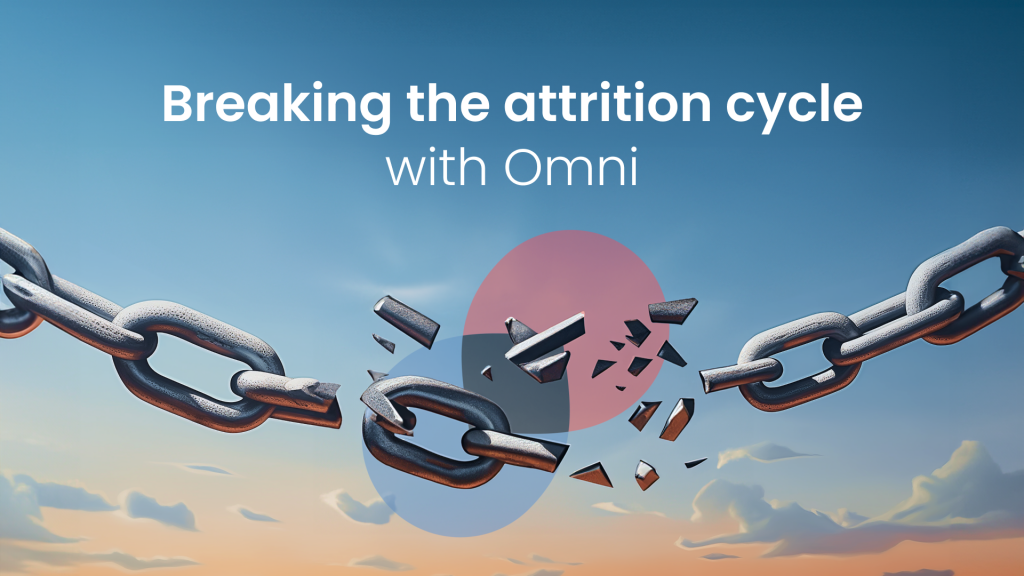In 2022, the average employee attrition rate across Asia Pacific was 13%, compared to 13.7% in 2021. Globally, attrition rates have followed this same trend of slight decreases, according to a Statista survey. Low employee turnover is key to a healthy company. But experts suggest aiming for less than 10% attrition to maintain a stable and productive workforce. This sweet spot minimizes disruptions and talent shortages, keeping your team running smoothly.
Achieving this ideal range of attrition is attainable with the right tools and strategies. Here, we’ll review how to calculate attrition rate of employees, as well as strategies for decreasing attrition. Decreasing attrition can help minimize hiring costs, identify areas of improvement in your workforce planning, and improve your organizational culture.
What is attrition rate?
Before we learn how to calculate attrition rate of employees, let’s explore what exactly companies mean when they talk about attrition rate. In simple terms, attrition rate is a metric for the number of employees or clients that you lose over time and don’t replace, and is a percentage of the total workforce or customer base.
In this article, we’re looking at the attrition rate for employees, known as the churn rate. This rate is a metric for the permanent decrease of staff numbers in an organization.
Whereas the turnover rate refers to the overall loss of employees, the attrition rate refers to the loss of employees that you don’t make up for with new hires over time.
Why are attrition rates important?

As an HR leader, understanding how to calculate attrition rate of employees and knowing how many employees leave your company is an important metric to help understand your employee experience, company culture, and the overall health of your organization.
This rate can help you estimate the effectiveness of your retention efforts, how loss of staff impacts organizational dynamics, and the number of vacant or removed positions. This way, you can identify development opportunities.
High attrition rates can signal a serious issue and a need for systematic changes, such as leadership changes, company culture rebrands, or adjustments to your people strategy.
Not to mention, the recruitment process and backfilling costs that come with losing employees are expensive and time consuming, making understanding and tackling attrition an essential part of HR.
Types of Employee Attrition
Aside from how to calculate attrition rate of employees, distinguishing the four main types of attrition is helpful in understanding the motivations behind employee attrition, proving HR teams the insights to tackle attrition head on.
- Voluntary: Voluntary attrition is when an employee willingly decides to leave the company, this can be due to personal reasons such as moving or health concerns, retirement purposes, or problems within the company such as poor leadership or dissatisfaction with company culture.
- Involuntary: Involuntary attrition is when an employee leaves the company involuntarily, often by termination or layoffs. This could happen for various reasons, including organizational restructures, performance issues, or economic reasons such as a loss of company funding.
- Internal: Internal attrition doesn’t necessarily mean an employee has left the company, but has moved departments or divisions, vacating their previous role.
- Demographic-Related Attrition: If a specific group of a certain age, ethnicity, gender, or demographic leaves suddenly and unexpectedly, that’s a demographic-related attrition. This type of attrition is a major red-flag, as it indicates there’s a form of discrimination within the company, or a broader company culture that is non-inclusive or welcoming.
Common Causes of Attrition
Now that you know the types of employee attrition, it’s equally important to understand the root causes of attrition before you learn how to calculate attrition rate of employees. Understanding the common causes of attrition equip you with the information needed to address the systemic or one-off issues within your organization, helping to reduce your attrition rate.
- Personal reasons: There are countless personal reasons an employee may choose to leave their role. Ranging from life circumstances such as marriage, care-taking, health challenges, or pursuing a career change. Personal reasons are often outside of an organization’s control, and are less concerning than other causes of attrition. However, HR teams should observe and monitor for patterns. For example, if employees are leaving your organization after becoming parents, it could be an indicator that your policies and benefits are not supportive of working parents, and warrant an evaluation.
- Job dissatisfaction: Job dissatisfaction is another common reason for attrition. Employees may find their jobs unfulfilling due to negative environments, low compensation, lack of growth opportunities, misalignment with the company’s goals and their own professional goals.
- Promotions: One of the more positive reasons for attrition, if an employee is promoted to a new role, this would be considered attrition.
- Retirement: Another typically non-concerning cause of attrition is retirement, also called natural attrition.
- Poor performance or misconduct: A company might let go of an employee for disruptive or poor performance, which is a functional form of attrition.
- Economic conditions: Economic conditions (like recessions) might force you to reduce your workforce, freeze salaries, or pause recruitment and hiring efforts.
- Industry shifts: Changes in the business landscape can alter staffing requirements, such as the replacement of certain positions with automation tools.
Calculating Your Team’s Attrition Rate
Learning how to calculate attrition rate of employees is more straightforward than you may think, and understanding how employee data is determined can help you better understand the contributing factors and how these numbers can affect your organization. Let’s take a look at how you can approach calculating your company’s attrition rate.
- Determine the time-period you’d like to calculate for, this can be done by quarter, month, year etc.
- Add the number of employees you started the period with to the number of employees you ended the period with.
- Divide the sum by two to get the average number of employees for that period.
- Now divide the number of employees who left the company (you’ll calculate this by subtracting the number of employees at the end of the period from the number of employees at the beginning of the period) by the average number of employees that you calculated in step 3.
- Multiply the number by 100 to get the rate as a percentage.
Let’s say you want to calculate attrition rate for the year 2023. If you started the year with 300 employees and ended it with 288 employees, here’s how to calculate attrition rate of employees in that case:
- 300 + 288 = 588
- 588/2 = 294 (the average number of employees for 2023)
- (300 – 288)/294 = 12/294 ≈ 0.04
- 0.04 x 100 = 4%
- Your attrition rate for 2023 was 4%
Tools and Strategies to Improve Retention

High rates of attrition are opportunities to review your organization, People strategy, and performance management processes to find areas of improvement for your company. As retention is one of the leading indicators of a positive organization, it’s understandably an important initiative for HR teams.
Let’s take a look at some of the tools your team can use to help decrease attrition rate and thus improve employee retention.
HRIS
A Human Resources Information system (HRIS) can be a powerful tool in improving retention, boosting productivity, and cultivating a strong company culture.
Automated workflows and employee feedback systems help HR teams to stay on top of initiatives like employee training and development, acknowledging engagement opportunities such as work anniversaries through automated reminders, conducting consistent and smooth onboarding and performance review cycles, and equipping HR teams with real-time data on employee performance and engagement.
HRIS can help determine employee performance gaps, identify trends, and calculate attrition rates, so HR teams can react swiftly and effectively to get ahead of issues that may increase attrition rates.
Not to mention, HRIS are often equipped with employee self-service tools, allowing employees to manage their time and benefits, which has been shown to improve engagement and boost employee satisfaction.
Employee Feedback Tools
Employee feedback is something organizations should prioritize regardless of attrition, however in the cases where you learn how to calculate attrition rate of employees and find that it’s concerningly low, employee feedback is one of the best ways to figure out where you’re going wrong.
Feedback tools are a great way to give employees a platform (often anonymous) to voice their concerns, opinions, and experiences in a constructive and strategic way. This gives HR and CEOs a direct eye into what is and isn’t working within their organization, and can help identify pain points or potential issues before they grow.
Asking for feedback shows employees that you care about their happiness and growth, which boosts morale, improves employee satisfaction, helps you identify issues before they escalate, ultimately increasing employee retention rates. Of course, these tools only work if you take action based on the feedback you receive.
Employee Recognition Platforms
Employee recognition is an effective way to keep employees motivated and engaged, helping reduce attrition rates. In fact, a survey found 65% of employees said recognition would incentivize them to work harder.
Employee recognition platforms are great tools to facilitate recognition programs, streamlining efforts and providing a platform to easily celebrate the wins of your team. These platforms help you recognize employee successes and milestones, such as outstanding performances, birthdays, and anniversaries.
Such platforms make that possible via reward points, gift cards, virtual clapping, digital badges, appreciation messages, and recognition certificates. Ultimately, they support employee recognition and, sometimes, peer recognition, which strengthens the culture and improves retention.
Learning and Development
Learning and development (L&D) is a process to help your employees improve their skills and provide them with opportunities for professional growth, and is an important initiative to keep employees engaged and happy in their roles. These growth-oriented programs create a value-based company culture, which helps promote loyal and committed employees.
L&D tools can gamify and streamline development initiatives, with various tools and tactics to keep employees engaged. By automating your growth program, you can track course completion and engagement, helping you ensure employees are getting the most out of the program.
Flexible Work Arrangements
Another way to decrease your attrition rates is by providing flexible work arrangements, a trend with growing popularity among employees due to the work-life balance they enable.
Flexible work arrangements can range from fully remote to hybrid work models, and can even exist in in-person environments that have flexible hours or time-off policies. Flexible work attracts high-performing employees, increases retention rates, inclusivity, diversity, and productivity, and can minimize overhead costs, making it a win-win for employees and their employers.
Employee Onboarding
Once you learn how to calculate attrition rate of employees, the results may surprise you. Lack of employee engagement can begin as soon as the onboarding process. As the first impression for new hires, onboarding is a crucial moment in the employee lifecycle, contributing to engagement and determining the success of employees.
Consistent, comprehensive onboarding programs help set employees up for success, immediately aligning them with the goals of your organization, setting expectations for performance, communicating benefits and feedback channels, and laying the foundation for a positive and productive work environment.
Whether in-person or remote onboarding, your program can have a significant impact on your attrition rate, and can be a great place to start when determining strategies to improve your retention.
HR software can help streamline onboarding efforts, giving your new hires an enhanced employee experience, and ensuring consistent, timely, and effective onboarding.
HR Analytics
HR analytics measure the successes and failures of how well your company is performing when it comes to its employees. Analytics is a broad term, and can measure just about anything from the demographics of your workforce to engagement rates, performance gaps, goal completions, and ROI of your employees.
Accordingly, HR analytics tools can help you with how to calculate attrition rate of employees. To increase retention, you can dig into HR analytics software to generate the data that helps you determine factors such as employee engagement, morale, and performance. These are all useful indicators for determining attrition rate, forecasting potential pain points that can contribute to attrition, and identifying where you are excelling in your People management.
How Omni Helps Modern Companies Lower Their Attrition Rate

Real-time employee data and analytics
Keeping your finger on the pulse of your workforce helps mitigate attrition rate risks such as dips in employee engagement or performance skill gaps. Omni centralized and tracks a wide range of employee data, from attendance records to attrition rate, automatically within our platform. Real-time graphs and easily exported reports simplifies employee analytics and cuts down on calculation times and errors, arming you with the data you need to understand the trends within your organization.
Employee attrition rate can be easily accessed for monthly, quarterly, annually, or any custom range of dates within minutes, making it easier for HR leaders and CEOs to keep track of their churn rate and address pain points at the first sign of trouble, helping to reduce your attrition rate and improve employee retention.
Automated performance management tools
Omni’s performance management tools bring consistency, organization, and accountability to your organization without the need for disjointed systems or spreadsheets. Set and track employee goals, set up automated reminders and monitor progress of performance review cycles, collect anonymous feedback from peers and managers, and create learning and development tracks all within one, centralized platform.
Omni simplifies the performance management process, reducing the time it takes to manage employee performance and boosting engagement to help manage attrition rate.
Customized employee experience
Customization that allows you to meet the unique needs of your business, Omni is built to personalize your employee’s experience with deepened engagement and promote a strong organizational culture.
Here’s a look into just a few of the ways Omni helps personalize your HR functions for maximum engagement:
- Automated calendar reminders so you never miss a birthday, work anniversary, or holiday. Calendars can be personalized and localized to your team’s location, helping you keep your finger on the pulse of local happenings to capitalize on opportunities to engage your employees.
- Bespoke onboarding programs mean HR can build out unique and tailored experiences for your employees. Think templates for remote onboarding, exec onboarding, and hybrid onboarding at your fingertips to easily provide a personalized experience to new hires in a matter of minutes. Automated fields make it easy to input personalized touches such as names and position titles for large batches of employees without the hassle of manual entry.
- Employee self-service tools mean your employees are empowered to access and manage their benefits (a key driver of engagement) without the intervention of HR. Automated leave allowance calculations, time-off request workflows, profile management and more help put your employees in the driver’s seat.


